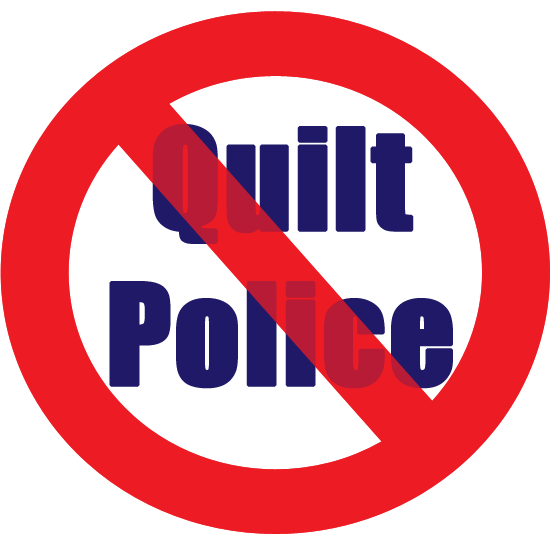- Home
- Machine Quilting 101
- Ditch Quilting
Stitch in the Ditch Quilting Basics:
The 'Top Ten' List!
Beginning Machine Quilting 101 continues...
This post contains affiliate links, for which I receive compensation.
Ditch quilting (also referred to as stitch in the ditch) is really just as simple as sewing on the lower side of a seam, as close to the seam as possible.
Your feed dogs are up and engaged.

That means your job is steering and maneuvering the sandwich.
Your sewing machine will do the rest.
It doesn't add much texture to your patchwork nor does it add another layer of design.
But it is an efficient way to turn a pieced top into a quilt with a just a short learning curve. It's a skill to make your own!
Guidelines for better ditch quilting
Notice it's 'guidelines' and not 'rules'.
It's YOUR quilt!
YOUR time!
Use these tried and true suggestions to help you develop good habits that build your skills and let enjoy your time finishing your patchwork projects. So much so that you want to finish another, and another, and another!
Let's get started!

#1 Sit in front of the needle
It's so much easier on your body.
This way you don't excessively strain your body by holding it tensely in some cockamamie position in order to see what you're stitching.

Some sewing tables aren't aligned quite right and you should be mindful of your position so that you can quilt for longer periods of time.
That's the bottom line, preserving your quilting-time.
And while you're at it, set a timer or get...and drink...a really big glass of water so that you ABSOLUTELY MUST get up and move every so often. At least every half hour.
It's
quite easy to lose track of the time and then find you've sat, body
clenched, for three hours. That's the fastest way to end up hating to
quilt.
#2 Focus your eyes on where the needle pierces the fabric
With ditch quilting, those stitches are placed as close as possible to the folded edge, without hitting it. Since the stitch lines are straight, you needn't be looking ahead for upcoming changes in direction.
Focus on the needle.
#3 Starting and stopping a line of stitches
Regardless of whether you are free motion or ditch quilting, you'll need to anchor your stitches at the beginning and end of a line.
For quilting that begins at the outside edges of your quilt top, there is no need for knot-tying, backstitching or backtacking of any kind. After the quilting is finished and the quilt is squared up, the stitches that eventually attach the binding secure these.
Do start an inch or so outside or past the edge so that these threads don't pull out and need to be re-sewn as you pull the sandwich in and out from under the needle. Re-quilting is a hassle to do because you're thisclosetotheend!
Stitching that begins within the edge of the quilt must be secured so that the thread tails don't pull out. (Think stitches that begin inside the borders.)
You can either choose to hand knot and bury the thread tails or tie off using microstitches. Whichever method you choose, just be sure to do it. Every time.
A word about the 'fix stitch'... Newer model sewing machines may have this option. With a push of a button, your machine sews in place for several stitches creating a knot (or thread lump as I see it) on the back. This knot, to me, is unsightly and I'm not convinced of it's staying power through the washing machine. I don't use it for quilting.
#4 Ditch quilting on the 'low' side
In a perfect world, all seam allowances would be pressed to the dark side for consistency.
However, we may choose to press to the light or with seams open to reduce bulk or prevent shadowing. Perhaps the patchwork was paper pieced and then the direction for pressing is determined solely by the order of piecing, and not the fabric's color.
You will be able to feel which side of the seam is high with your fingertip. The trick is to REMEMBER TO FEEL FOR IT before sewing the upcoming section of seam.
Then stitch on the lower side as close as possible to where the fabrics are joined.
Be aware that for a single line of stitches it is almost certain that you will switch from one side to the other of the seam at least once while ditch quilting.
That's just how it is!
#5 For invisible stitches...
...place them as close as possible to the seamline.
Sometimes it helps to gently ease open the seam with your fingertips—with just enough tension to hold it taut. If you pull too hard, it is possible to get a little rippling. You want to avoid that. In most instances, it's not catastrophic, but you know it's there.
If you have trouble getting right up next to the seamline, try switching to the next smaller size needle. As you watch where the needle hits the fabric, you may be focusing on the shaft of the needle and not the point.
#6 Sew at YOUR speed
Ditch quilting is not a race. If you need to sew slower to maintain control, DO IT! If your machine has a speed control, USE IT!
It is much faster to quilt slower.
Yes! You did read that right.
Not having to spend any time ripping out lines of stitches is a huge timesaving. The only thing that sucks more than frog-stitching (Rip-it! Rip-it! Rip-it!) is ripping a hole in your quilt top with a seam ripper.
Slower is faster!
#7 When seams don't match...
...you still sew in the ditch.
In the picture, this four patch didn't match up too well. Instead of angling to the next ditch, stop with your needle down at 'A'. Raise the presser foot to release the tension disks and move the quilt sandwich a bit to the right.
Hand walk your needle back into the sandwich at 'B' on the low side (feel for it with your fingertip). Put the presser foot back down and start sewing again. The thread stays out of sight.
#8 Avoid turning the quilt under the needle
Huh-what?
Really. This one is tricky. Probably the hardest one to make your own because it feels counter-intuitive.
When you have a table runner or small wallhanging to quilt (and I counsel my beginning students to start with smaller projects to build up their 'quilting-muscles'), it's so easy to just stop with the needle in the sandwich, raise the presser foot, pivot the quilt, lower the presser foot and continue sewing.
And usually there are no issues.
The problem is, when you're working on a quilt the 'size of Egypt', and particularly in the middle of it, turning the quilt under the needle begets all sorts of problems.
You're stuffing and tugging the whole weight of the project on that tiny, little, miniscule needle, and then hoping that everything is arranged Oh! so smoothly underneath it as you resume sewing.
There's a huge possibility that with each pivot you'll either create a tuck in the back, or sew more than the three layers together in sections.
Both occurrences are heartbreaking to find after an hours-long ditch quilting session.
If you practice not pivoting your quilt under the needle on the smaller, beginning projects, you stand a much better chance developing the habit of starting and stopping. Tying off in some manner. Turning the quilt. And THEN beginning a new line.
The habit has to start somewhere, so that you can rely on it for the bigger, more physically taxing projects. Form it at the beginning!
#9 Don't walk your hands
It's all about safety and control.
If the needle is moving, your hands and/or fingertips need to be in full contact with the quilt.
Your job is to steer when the feed dogs are engaged and if you're walking on your fingertips as the stitches are formed, you're not quite in control. Kind of like walking on marbles—you're going in one direction and the marbles in another.
When you get to free motion quilting, you'll be especially happy you've developed this discipline.
AND FINALLY...
...#10 Enjoy yourself!
Ditch quilting is a utilitarian way to finish a quilt.
It gets the job done, but it doesn't add much in the way of texture (a huge 'thing' in the quilting world) nor does it add that mysterious layer of design, the one that beckons a viewer to 'come hither' and enjoy the view.
Ditch quilting is the solid foundation on which you'll build your free motion skills. You'll go back to it again and again. Project after project.
Do everything you can to make and keep it an enjoyable experience so that you are able to finish your own quilts, on your home sewing machine.
So that you can revel in your accomplishments and enjoy the satisfaction of having quilted your own quilt.
I know you can do it!
Table of Contents
for Beginning Machine Quilting 101
Introduction
Beginning Quilting 101: Quilting Instructions for the Beginner















